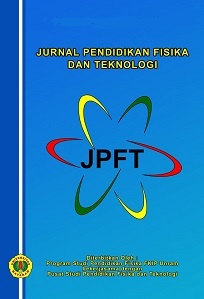Pengembangan Perangkat Pembelajaran Fisika Berbasis Moodle
DOI:
10.29303/jpft.v3i2.412Published:
2017-12-20Issue:
Vol. 3 No. 2 (2017): Juli - DesemberKeywords:
learning tools, Moodle, physicsArticles
Downloads
How to Cite
Downloads
Metrics
Abstract
The purpose of this research is to develop a physics learning tools with Moodle that can be used on students in physics courses. The type of this research is Research and Development (R & D). Research and Development is a process or steps to develop a new product or refine an existing product, which can be accounted for. Broadly speaking, the R & Dââ¬â¢s steps consisted of three stages, namely: preliminary study, design/model development, and model testing. The subject of this research is a student of Department of Physics Education at FPMIPA IKIP Mataram who is studying at Odd Semester Academic Year 2016/2017. Based on the validation of physics learning tools with Moodle, it obtained products that have been validated with a good categorized score and can be used for the next stage. The development of Moodle-based learning tools developed was complemented by textbooks, Moodle guides, and assessment instruments.References
Boud, D., & Feletti, G. 1997. The challenge of problem-based learning. Psychology Press.
Chaeruman, U. 2010. E-learning dalam pendidikan jarak jauh. Jakarta: Kemendiknas.
Cheng, K.K., Thacker, B. A. & Cardenas, R. L. 2004. Using Online Homeworks Systems Enhances Student. Learning of Physics Concept in an Introductory Physics Course. American Journal of Physics. 72 (11) 1447-1453.
Cheng, K.K., Thacker, B. A. & Cardenas, R. L. 2004. Using an online homework system enhances students learning of physics concepts in an introductory physics course. Journal American Association of physic Teacher, 72(11), 1119.
Gunawan. 2015. Model pembelajaran sains berbasis ICT. Mataram. FKIP Universitas Mataram.
Hartley, D. E. 2006. Selling e-learning. American Society for Training and Development.
Herayanti, L. Habibi. 2015. Model Pembelajaran Berbasis masalah Berbantuan Simulasi Komputer untuk Meningkatkan Keterampilan Berfikir Kritis Calon Guru Fisika. Jurnal Pendidikan Fisika dan Teknologi, 1(1), 61-66.
Herayanti, L., Fuaddunnazmi, M., & Habibi, H. 2015. Pengembangan Media Pembelajaran Berbasis Moodle pada Mata Kuliah Fisika Dasar. Jurnal Pendidikan Fisika dan Teknologi, 1(3), 205-209.
Herayanti, L., Habibi, H., & Fuaddunazmi, M. 2017. Pengembangan Media Pembelajaran Berbasis Moodle pada Matakuliah Fisika Dasar. Jurnal Cakrawala Pendidikan, 36(2).
Herayanti, L., Setiawan, A., & Rusdiana, D. 2009. Model Pembelajaran Berbasis Masalah dengan Pendekatan Inkuiri untuk Meningkatkan Keterampilan Generik Sains Mahasiswa pada Materi Listrik Statis. Jurnal Penelitian Pendidikan IPA, 3(2), 145-152.
Herayanti, Lovy. 2012. Model Pembelajaran Berbasis Masalah dengan Pendekatan Inkuiri untuk Meningkatkan Keterampilan Generik Sains Mahasiswa. Jurnal Kependidikan, 11(1),
Hermansyah, H., Gunawan, G., & Herayanti, L. 2015. Pengaruh Penggunaan Laboratorium Virtual Terhadap Penguasaan Konsep dan Kemampuan Berpikir Kreatif Siswa pada Materi Getaran dan Gelombang. Jurnal Pendidikan Fisika dan Teknologi, 1(2), 97-102.
Maryani, S. 2012. Pengembangan Bahan Ajar Berbasis Multimedia Interaktif Mata Kuliah Komputerisasi Akuntansi (Studi Kasus: Myob Accounting 17 Pada Modul Banking) penguasaan konsep dan keterampilan berpikir kritis mahasiswa. Jurnal Kependidikan, 10(1),-.
Pratiwi, Y. I., Budiharti, R. & Ekawati, E. Y. 2014. Pengembangan media pembelajaran IPA terpadu interaktif dalam bentuk moodle untuk siswa smp pada tema matahari sebagai sumber energi alternatif. Jurnal Pendidikan Fisika, 2(1), 26.
Purwaningsih, D. & Pujianto. 2009. In Blended Cooperative E-learning sebagai sarana Pendidikan Penunjang Learning Communityââ¬Â makalah disampaikan dalam seminar nasional UNY dengan tema Peranan ICT dalam Pembelajaran. Yogyakarta (25).
Rice, W., & Nash, S. S. 2010. Moodle 1.9. Teaching Techniques.
Safitri M. R., Budiharti, R. & Ekawati, E. Y. 2014. Pengembangan Media Pembelajaran IPA Terpadu Interaktif Dalam Bentuk Moodle Untuk Siswa SMP pada Tema Hujan Asam. Jurnal Pendidikan Fisika. 2(1), 1-5.
Sampurno, P. J., Maulidiyah, R. & Puspitaningrum, H. Z. 2015. Implementasi Kurikulum 2013: MOODLE (Modular Object Oriented Dynamic Learning Environment) Dalam Pembelajaran Fisika Melalui Lembar Kerja Siswa Pada Materi Optik Di SMA. Jurnal Pendidikan Indonesia, 19(56), 54-58.
Saver, J. L. 2006. Time is brainââ¬âquantified. Stroke, 37(1), 263-266.
Sohn, B 2005. E-learning and primary and secondary education in Korea. Korea education & Research Information Service.
Sohn, T., Li, K., Lee, G., Smith, I., Scott, J., & Griswold, W. 2005. Place-its: A study of location-based reminders on mobile phones. UbiComp 2005: Ubiquitous Computing, 903-903.
Sucita, I. N. 2010. Pemetaan Kompetensi Guru Matematika. Majalah Saraswati. Edisi II. Halaman, 15-17.
Sugiarto, B. 2010. Kimia Dasar untuk Pendidikan Sains. Surabaya: UNESA.
Sukmadinata, R. Nana Syaodih. 2015. Metodologi Penelitian Pendidikan.
Tan, O. S., Chye, S., & Teo, C. T. 2009. Problem-based learning and creativity: A review of the literature. Problem-based learning and creativity, 15-38.
Tasri, L. M. 2011. Pengembangan Bahan Ajar Berbasis Web. Jurnal Medtek, 3(2), 2-8.
License
Authors who publish with Jurnal Pendidikan Fisika dan Teknologi (JPFT) agree to the following terms:
- Authors retain copyright and grant the journal right of first publication with the work simultaneously licensed under a Creative Commons Attribution License 4.0 International License (CC-BY-SA License). This license allows authors to use all articles, data sets, graphics, and appendices in data mining applications, search engines, web sites, blogs, and other platforms by providing an appropriate reference. The journal allows the author(s) to hold the copyright without restrictions and will retain publishing rights without restrictions.
- Authors are able to enter into separate, additional contractual arrangements for the non-exclusive distribution of the journal's published version of the work (e.g., post it to an institutional repository or publish it in a book), with an acknowledgement of its initial publication in Jurnal Pendidikan Fisika dan Teknologi (JPFT).
- Authors are permitted and encouraged to post their work online (e.g., in institutional repositories or on their website) prior to and during the submission process, as it can lead to productive exchanges, as well as earlier and greater citation of published work (See The Effect of Open Access).











